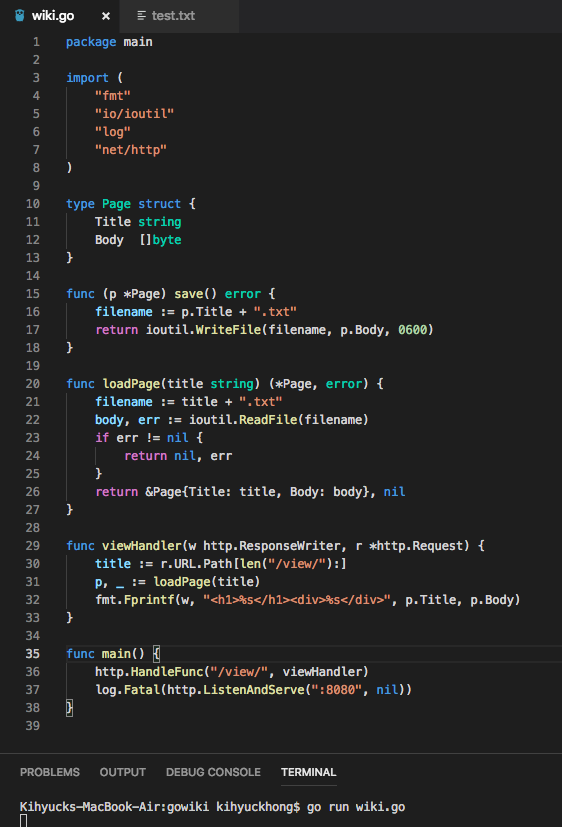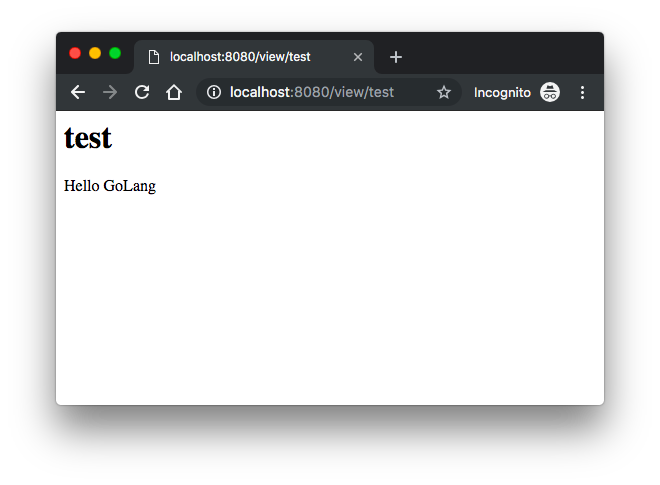GoLang Tutorial - Web App 2 (Using net/http)
Continued from Web Application Part 1.
In this post, we'll be using the net/http to serve the wiki pages we created in the previous tutorial.
Users need to view our wiki page. To do that we may want to create a handler, viewHandler which will handle URLs prefixed with /view/.
func viewHandler(w http.ResponseWriter, r *http.Request) {
title := r.URL.Path[len("/view/"):]
p, _ := loadPage(title)
fmt.Fprintf(w, "<h1>%s</h1><div>%s</div>", p.Title, p.Body)
}
Not that we used "_" to ignore the error return value from loadPage. This is done here for simplicity and generally considered bad practice. We will take care of this later.
First, this function extracts the page title from r.URL.Path, the path component of the request URL. The Path is re-sliced with [len("/view/"):] to drop the leading "/view/" component of the request path. This is because the path will invariably begin with "/view/", which is not part of the page's title.
The function then loads the page data, formats the page with a string of simple HTML, and writes it to w, the http.ResponseWriter.
To use this handler, we rewrite our main function to initialize http using the viewHandler to handle any requests under the path /view/:
func main() {
http.HandleFunc("/view/", viewHandler)
log.Fatal(http.ListenAndServe(":8080", nil))
}
We need a page data (as test.txt) like this:
Hello GoLang
Then, compile our code, and try serving a wiki page:

With this web server running, a visit to http://localhost:8080/view/test should show a page titled "test" containing the words "Hello GoLang":

Continues to Web Application Part 3 (Adding "edit" capability).
Go Tutorial
- GoLang Tutorial - HelloWorld
- Calling code in an external package & go.mod / go.sum files
- Workspaces
- Workspaces II
- Visual Studio Code
- Data Types and Variables
- byte and rune
- Packages
- Functions
- Arrays and Slices
- A function taking and returning a slice
- Conditionals
- Loops
- Maps
- Range
- Pointers
- Closures and Anonymous Functions
- Structs and receiver methods
- Value or Pointer Receivers
- Interfaces
- Web Application Part 0 (Introduction)
- Web Application Part 1 (Basic)
- Web Application Part 2 (Using net/http)
- Web Application Part 3 (Adding "edit" capability)
- Web Application Part 4 (Handling non-existent pages and saving pages)
- Web Application Part 5 (Error handling and template caching)
- Web Application Part 6 (Validating the title with a regular expression)
- Web Application Part 7 (Function Literals and Closures)
- Building Docker image and deploying Go application to a Kubernetes cluster (minikube)
- Serverless Framework (Serverless Application Model-SAM)
- Serverless Web API with AWS Lambda
- Arrays vs Slices with an array left rotation sample
- Variadic Functions
- Goroutines
- Channels ("<-")
- Channels ("<-") with Select
- Channels ("<-") with worker pools
- Defer
- GoLang Panic and Recover
- String Formatting
- JSON
- SQLite
- Modules 0: Using External Go Modules from GitHub
- Modules 1 (Creating a new module)
- Modules 2 (Adding Dependencies)
- AWS SDK for Go (S3 listing)
- Linked List
- Binary Search Tree (BST) Part 1 (Tree/Node structs with insert and print functions)
- Go Application Authentication I (BasicAuth, Bearer-Token-Based Authentication)
- Go Application Authentication II (JWT Authentication)
Ph.D. / Golden Gate Ave, San Francisco / Seoul National Univ / Carnegie Mellon / UC Berkeley / DevOps / Deep Learning / Visualization